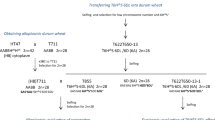Summary
58 varieties, strains or mutants of barley were tested in the msml cytoplasm in Finland, location ca. 61 N. Three (5%) were found to be partial restorers, the rest being maintainers of sterility. 31 Israeli strains of wild barley (ssp. spontaneum) were tested. About one third were maintainers of sterility, the majority partial restorers, and two strains were full restorers. There is probably polymorphism of the restorer gene in Israeli wild barley. Partial restoration displays an environmental response. The physiology of partial restoration is discussed.
Similar content being viewed by others
References
Ahokas, H. 1978a. Cytoplasmic male sterility in barley. I. Anther and pollen characteristics of msm1, restored and partially restored msml genotypes. Z. Pflanzenzücht. 81: 327–332.
Ahokas, H. 1978b. Cytoplasmic male sterility in barley. II. Physiology and anther cytology of msm1. Hereditas 89: 7–21.
Ahokas, H., 1979. Cytoplasmic male sterility in barley. Acta Agric. Scand. (in press).
Ahokas, H. & E. A. Hockett 1977. Male sterile mutants of barley. IV. Different fertility levels of msg9ci (cv. Vantage), an ecoclinal response. Barley Genet. Newslett. 7: 10–11.
Anonymous, 1977 & 1978. [Monthly climatological data]. Kuukausikatsaus Suomen ilmastoon. Vol. 71 & 72.
Bates, L. S., K. A. Muieeb, R. Rodriquez R. & R. F. Waters 1976. Rye dwarf gene introgression into Barley, Barley Genet. Newslett. 6: 7–8.
Bole, J. B. & S. A. Wells, 1977. Salinity tolerance of cereals. Agric. Canada, Canadex, Sept. 1977. 2p.
Brown, A., E. Nevo & D. Zohary 1977. Association of alleles at esterase loci in wild barley Hordeu spontaneum L. Nature 268: 430–431.
Brown, A. H. D., D. Zohary & E. Nevo 1978. Outcrossing rates and heterozygosity in natural population of Hordeum spontaneum Koch in Israel. Heredity 41: 49–62.
Fröst, S. & G. Holm 1975. Variation of flavonoid patterns in Hordeum spontaneum and H. agriocrithon. Hereditas 80: 167–172.
Hockett, E. A. & H. Ahokas, 1979. Male and female fertility levels ofgenetic male sterile barley grown at two different latitudes. Hereditas (in press).
Hockett, E. A. & R. F. Eslick 1968. Genetic male sterility in barley. I. Nonallelic genes. Crop. Sci. 8: 218–220.
Hyland, H. L., 1968. Plant material introduced January 1 to December 31, 1964 (Nos. 294439 to 303627). USDA, Pl. Inventory No. 172, Washington, D.C., 369p.
Stanley, R. G. & H. F. Linskens 1974. Pollen, biology, biochemistry, management. Springer-Verlag. Berlin, Heidelberg, New York. 307 p.
Verbeek, L. & H. K. Lichtenthaler 1973. Der Einfluss von Stickstoffmangel auf die Lipochinon-und Isoprenoid-Synthese der Chloroplasten von Hordeum vulgare L. Z. Pflanzenphysiol. 70: 245–258.
Author information
Authors and Affiliations
Rights and permissions
About this article
Cite this article
Ahokas, H. Cytoplasmic male sterility in barley. III. Maintenance of sterility and restoration of fertility in the msml cytoplasm. Euphytica 28, 409–419 (1979). https://doi.org/10.1007/BF00056599
Issue Date:
DOI: https://doi.org/10.1007/BF00056599



